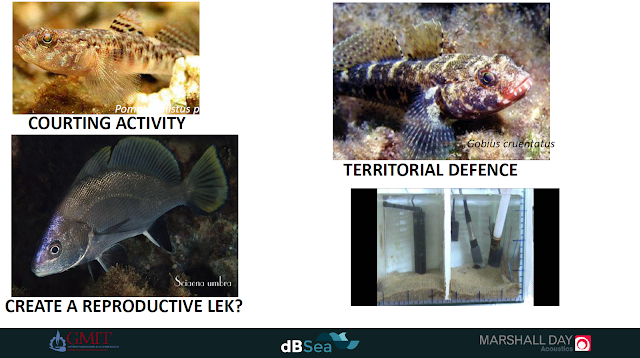dBSea Underwater Noise Course at GMIT, April 2016
We had the privilege of running this course with attendees from France, Denmark, United Kingdom, Greece and Ireland. We trust that the participants learned something from the event, but I must say that we learned much as well. It is amazing to have this amount of experience in one place to discuss the issues of the new and evolving field that underwater acoustics is.
 |
| Some of the common anthropogenic noise sources in the sea. |
For this course we were fortunate enough to fit into a smaller room, making conversation and discussion much easier. Much of the info was accessible on the participants on their own computers and the big monitor Martin is pointing at below could be effectively used for demonstrations and sharing of model results.
 |
| Martin points to a very important point on the results colour grid. |
Even the maths nerd were well catered for as we were led through the ins-and-outs of parabolic equations, normal modes and ray tracing - all these approximate the sound field around one or multiple sources. Because they are all approximations they have strengths and weaknesses, and knowing the theory will assist you in making the correct choices.
 |
| Some steps in understanding the way the parabolic equation solver works in dBSea. |
Aside from the technical stuff, we had Amanda Robinson (Associate director Marshall Day Acoustics Australia), Martin Keane (dBSea developer), Raymond Alcorn (CEO Exceedence Ltd) and Joanne O'Brien (GMIT) brought in to give us insights into the industry application of modelling software, along with present and historical industry cases. Amanda provided insight into the noise assesment involved with the salvage operation of one of the biggest ship groundings in New Zealand ever. All containers were removed, and the hull of the ship is now an addition to the natural reef below.
 |
| Pictures from the RENA salvage operation in NZ. Noise modelling was involved in minimising ecosystem damage during salvage activities. |
The biologist in me was very exited about the presentation of data, on the hearing and sonic capabilities of fish and invertebrates. They rely on particle motion as well as pressure for sensing and communicating, making impact assessment all the more challenging. Particle motion is not well understood compared to sound pressure, this is a knowledge gap the community is working to close. Understanding what noises drive the displacement of fish has great economical value and ecological importance.
My own contribution to the course mostly consisted of summarising some of the main points of underwater noise management, and driving home the point that sound really behaves different underwater compared to the air-borne noise we are so used to (as evident from earlier posts on this blog!).
 |
| "Ducting" can cause sound to travel very strangely in water (see more). |
We aimed to present real data in a relevant context, believing that this furthers understanding and motivation better than detached information that has to be contextualised individually later on. This to encourage an all-round learning that we hope will develop a more intuitive understanding of underwater noise. Compare the figure below with
this blog post to see why a systemic approach is necessary to understand impacts of noise.
 |
| Sample spectra of anthropogenic noise sources compared to the frequency specific attenuation profile. Notice how attenuation steeply increases over 10 kHz (>1 dB/km). |
We hope to undertake more of these courses in the future, as we ourselves also benefit hugely from sharing some of our specialised knowledge with the industry, the universities, NGOs and government institutions.
Thanks for joining us for the course and thank for reading.
The dBSea/GMIT team









Comments
Post a Comment